There are a lot of cards that are popular in cEDH because they’re effective at preventing a wide range of opposing decks from doing their thing rather than because they help your deck further its own plan. The strongest of these cards have symmetrical effects rather than only stopping your opponents, but you break the symmetry by not trying to do the thing the card is preventing in the first place. Sometimes the effect is strong enough that it’s worth playing even if it hurts you a little because you can expect it to hurt others more. Today I want to look at the cards that I try to play whenever they don’t hurt me too much. Specifically, the artifacts because they don’t care about your commander’s color identity, so you always want to check whether your deck can afford them.
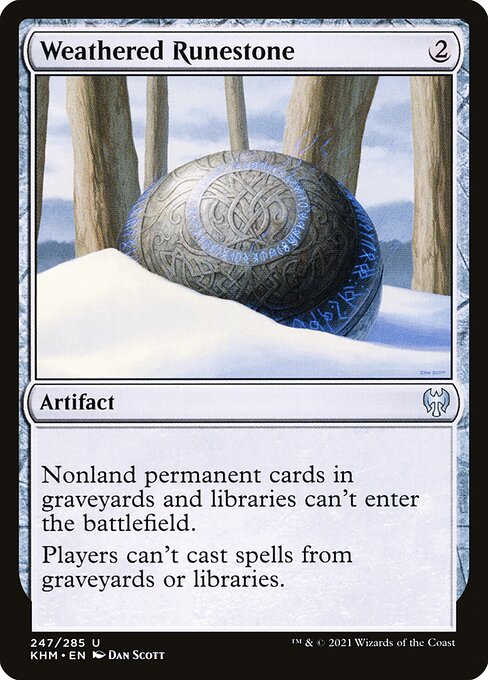
Weathered Runestone is fantastic in cEDH. It stops a lot of very strong commanders like Kinnan, Bonder Prodigy; Tayam, Luminous Enigma; Winona, Joiner of Forces; Magda, Brazen Outlaw and many others from doing the thing they’re trying to do while also preventing Underworld Breach, an extremely popular way to try to win a game, as well as a wide range of effective tutor effects like Chord of Calling, Finale of Devastation, Eldritch Evolution, Transmute Artifact, and countless other cards. This stops a wide enough range of decks that most decks can’t afford to play it themselves, but when you find a deck that can, it’s fantastic.
Green commanders will very rarely want this, and while it doesn’t impact too many red cards, a lot of red decks lean very heavily on Underworld Breach, so most of the decks that are interested in Weathered Runestone will be among Esper colors.
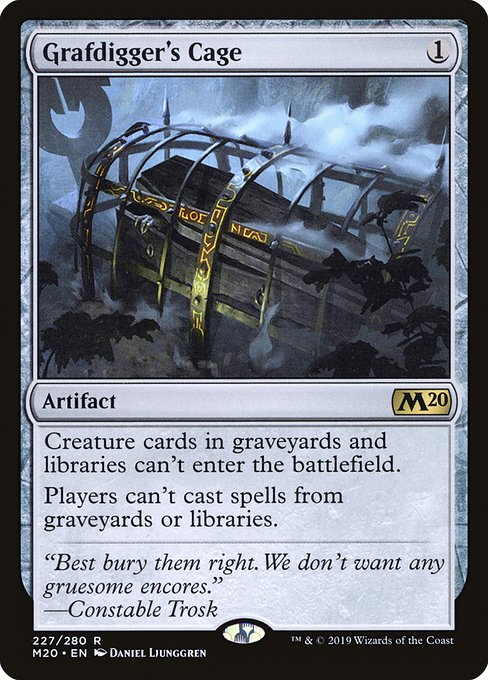
Grafdigger’s Cage is basically the same thing except it costs one less mana and only prevents creatures rather than all nonland permanents. Despite the fact that it accomplishes most of the same thing for one less mana, I think the difference between one and two mana here isn’t very important unless you’re considering it as a target for cards like Urza’s Saga, so I generally prefer the higher impact Weathered Runestone as long as that won’t create an additional burden for you. Really, I think these are strong enough that if you can get away with playing Weathered Runestone, there’s a good chance you should play both.

Null Rod is another that’s extremely impactful and hurts almost everyone, and decks that play it are almost always hurt by it somewhat themselves, which is to say even if you’re playing it you still probably want to play cards like Sol Ring and Mana Crypt. Artifact mana is a huge part of the format, and if you’re only playing a few cards that Null Rod turns off, it’s one of the most powerful defensive cards you can play.

Speaking of cards that are extremely impactful and hurt basically everyone, Uba Mask is an incredible tool for decks that don’t care about drawing cards/building a hand. This one I think most players aren’t familiar with–whenever a player would draw a card instead they exile the top card of their library and can only play it that turn, which means that once players have used any counterspells they had when Uba Mask entered the battlefield, there probably won’t be any more after that.
This is the most effective countermeasure to cards like Mystic Remora and Rhystic Study, and conveniently even stops cards like Sheoldred, the Apocalypse and Orcish Bowmasters from triggering.
I think this card is a little underplayed, and should be a serious consideration for any non-blue deck, in fact, I should probably add it to my own Tayam, Luminous Enigma deck.
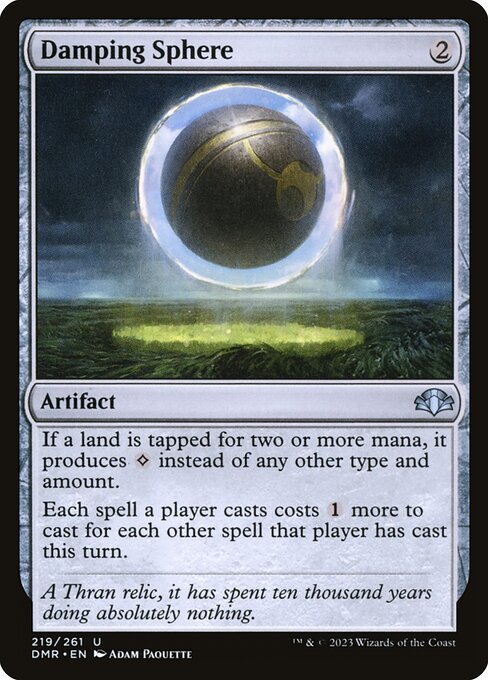
Damping Sphere has two basically unrelated effects. First, it makes lands that tap for more than one mana only produce a single colorless instead. Sometimes this will slightly nerf an Ancient Tomb, but the real impact is invalidating Gaea’s Cradle. Gaea’s Cradle is the best “green” card, so almost every green deck will be significantly hurt by this.
The second ability increasingly taxes every spell a player casts beyond the first, which makes any kind of storm turn impossible without executing an infinite mana combo first and also means that it becomes basically impossible to fight to resolve an attempted win, especially if it involves casting multiple spells to start as additional interactive spells just become too taxing, especially if multiple players are contributing the resisting spells, where each of them will be taxed far less.
Damping Sphere doesn’t do much to stop players from playing the game, but it’s remarkably effective at stopping them from winning the game, if you understand the distinction.

If the distinction is unclear, allow me to explain by comparing it to the opposite kind of effect, Trinisphere. An early Trinisphere has the potential to prevent players from doing anything at all if they don’t have three lands and were relying on casting spells to build mana, which is why I’d suggest that Trinisphere is better at stopping players from playing than stopping them from winning. Similarly, most proactive spells cost mana, while a lot of reactive spells in cEDH don’t cost mana. This means that when a player is casting spells in an attempt to win, Trinisphere may not increase the amount of mana required by very much, but when the table has to tap most of their mana to cast spells on their own turn, it means there will be minimal interaction available on other players turn as free counterspells will still require three mana. This means that it can actually make it easier to win by decreasing other players’ access to resistance, which is another reason it ends up having the opposite effect to Damping Sphere, favoring the active player rather than the resisting players.
Both cards are effective in decks that aren’t looking to cast a lot of spells, especially cantrips and rituals, but you should seriously consider which effect you want, since despite having a lot of similarities, they are in some way opposite cards.

Thassa’s Oracle and Dockside Extortionist are two of the most impactful creatures in the format, and Torpor Orb stops either one from doing anything. They’re far from the only victims. This is a format where creature size barely matters and creatures are played for their text box. A few creatures are playing for their abilities, but a huge portion of creatures are just played for their enters the battlefield abilities. If you have few creatures like that and aren’t relying on them Torpor Orb will make life difficult for most opponents.
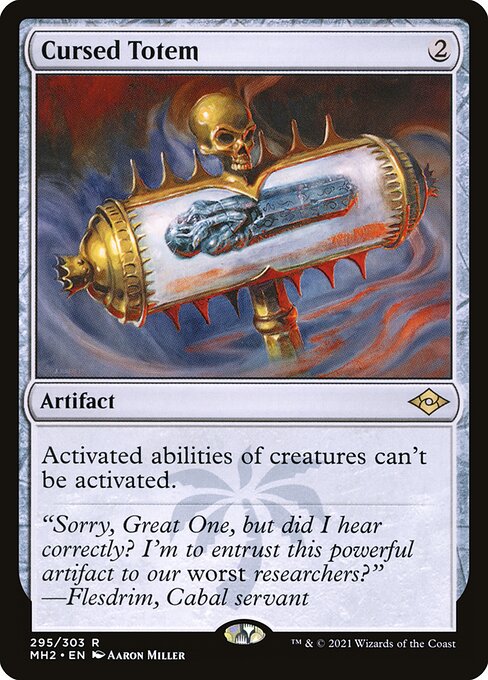
If Torpor Orb isn’t what you’re looking for, consider Cursed Totem. A lot of decks are built around the activated abilities of the commander they’re built around, and this turns them all off while also shutting down all opposing mana creatures and a host of other random popular creatures like Dauthi Voidwalker and Ranger-Captain of Eos. I think this card is pretty underplayed in decks like Tymna/Kraum.
Similar Cards I don’t Believe in:
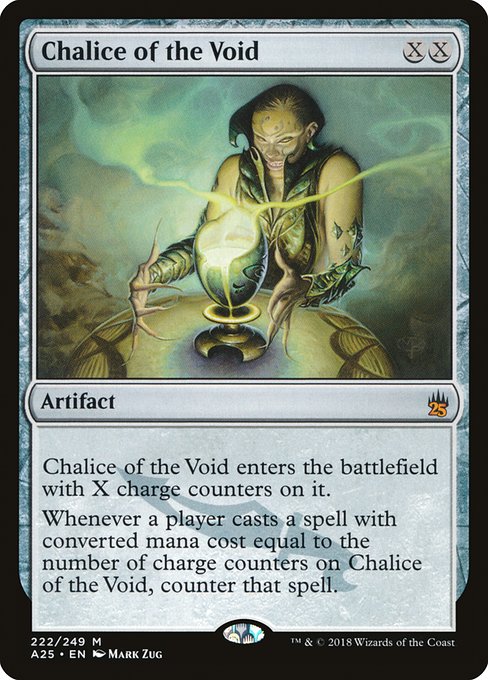
Chalice is a strange card–it doesn’t stop any particular strategy and generally stops people from doing things in a somewhat unpredictable way. For the most part, I don’t think Chalice of the Void is particularly strong on zero unless you’re the starting player, so you’d usually want to play it in a deck that’s happy to cast it on one, or maybe in some cases two. I think you’d only want to play it if it prevented very few of your cards on whatever number you intend to set it to, and it doesn’t really seem worth building around optimizing your single Chalice of the Void, so I mostly wouldn’t look to play it, but it could be something to consider.
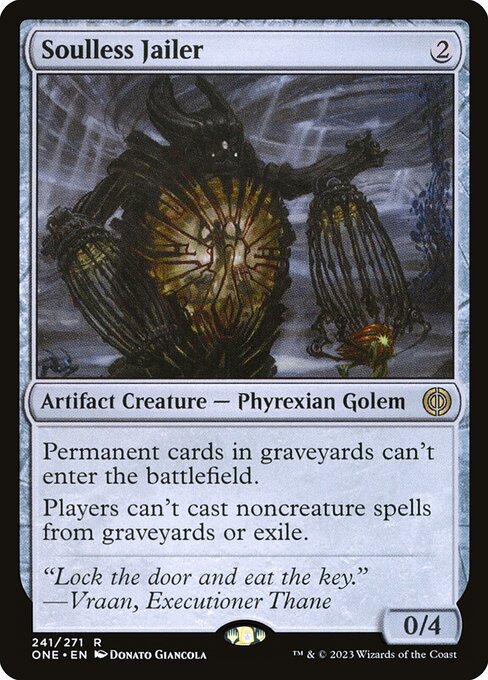
This can be effective against some decks, but it’s a bit narrow for my taste. It’s good against reanimation strategies, Underworld Breach, Mnemonic Betrayal, Jeska’s Will, and a few other things, but not preventing cards from entering from libraries has made it feel too narrow to me. To be clear, I do think this is close enough to good that I’ve played it in decks, so it’s worth keeping in mind, but when I’ve played it I’ve been disappointed a little too often to look to find windows to play it. Also being both an artifact and a creature makes it a lot more vulnerable when you do find an opponent it’s good against.
There are a lot of other artifacts that make it harder for players to do things like Winter Orb, Static Orb, Sphere of Resistance, etc that I don’t really think of in the same way as cards discussed here–these are generally cards you’ll want to play in a deck whose primary strategy is to restrict your opponent’s ability to cast spells, while the cards listed here are intended as cards that can be independently effective any time they happen to not interfere with what your deck is doing, and therefore can be included as something of an afterthought rather than as part of your core game plan.
Similarly a card like Defense Grid isn’t a card that stops other players from winning, rather it’s a card you can use proactively to make it easier to win. In practice, I’d say a card like Void Mirror, which might read otherwise, primarily functions in a role more similar to Defense Grid in that the primary role of Void Mirror is to counter free spells, which are mostly interactive spells.
Sam Black (any) is a former professional Magic player, longtime Magic writer, host of the Drafting Archetypes podcast, and Twitch streamer. Sam is also a Commander Cube enthusiast, and you can find Sam’s cube list here. For anything else, find Sam on Twitter: @SamuelHBlack.

